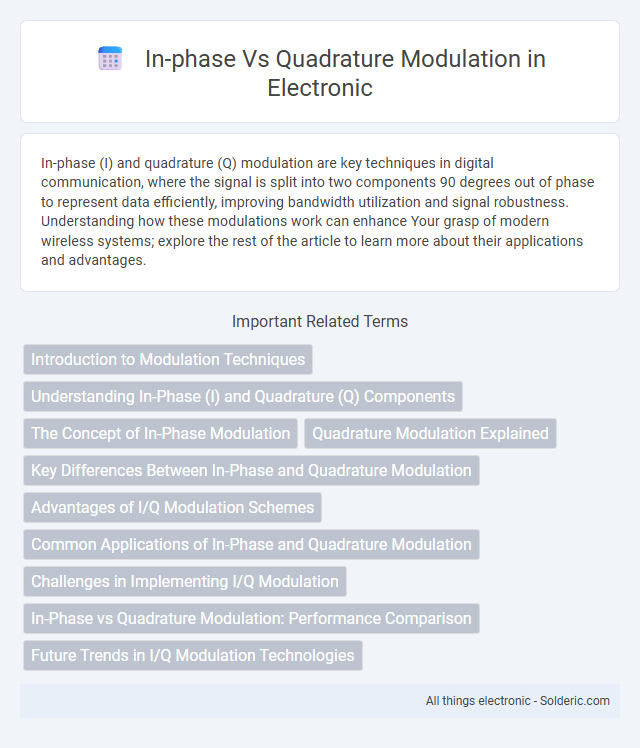In-phase (I) and quadrature (Q) modulation are key techniques in digital communication, where the signal is split into two components 90 degrees out of phase to represent data efficiently, improving bandwidth utilization and signal robustness. Understanding how these modulations work can enhance Your grasp of modern wireless systems; explore the rest of the article to learn more about their applications and advantages.
Comparison Table
| Feature | In-Phase Modulation (I) | Quadrature Modulation (Q) |
|---|---|---|
| Definition | Modulation of signal component aligned with reference carrier phase | Modulation of signal component 90deg out of phase with reference carrier |
| Signal Component | Cosine component | Sine component |
| Phase Shift | 0deg phase shift | 90deg phase shift |
| Role in Modulation | Controls amplitude or data on in-phase signal | Controls amplitude or data on quadrature signal |
| Applications | Used in amplitude modulation (AM), QPSK, QAM | Used in QPSK, QAM, OFDM systems |
| Orthogonality | Orthogonal to quadrature component | Orthogonal to in-phase component |
| Purpose | Facilitates separation of two data streams in complex modulation | Enables independent modulation of second data stream |
Introduction to Modulation Techniques
In-phase (I) and quadrature (Q) modulation techniques represent a fundamental approach in digital communication systems for encoding data onto carrier waves by manipulating amplitude and phase components separately. These methods enable efficient spectrum usage and improve signal robustness by transmitting two orthogonal signals simultaneously over the same frequency band, commonly used in QAM and QPSK schemes. Understanding I/Q modulation is essential for optimizing bandwidth efficiency and minimizing interference in wireless communication technologies such as 4G LTE and 5G NR.
Understanding In-Phase (I) and Quadrature (Q) Components
In-phase (I) and quadrature (Q) components are fundamental in complex signal modulation, representing two orthogonal signals that enable efficient data transmission. The I component corresponds to the cosine wave, while the Q component corresponds to the sine wave, allowing modulation of amplitude and phase simultaneously for precise encoding. Your communication system relies on accurate demodulation of these I and Q signals to recover transmitted information with minimal distortion.
The Concept of In-Phase Modulation
In-phase modulation refers to the process of varying the amplitude of a carrier signal in direct alignment with a reference signal's phase, typically denoted as the I (In-phase) component in communication systems. This technique enables efficient encoding of information by adjusting the signal's amplitude while maintaining a zero phase difference with the reference carrier, making it fundamental to digital modulation schemes such as QAM (Quadrature Amplitude Modulation). Your understanding of in-phase modulation is crucial for optimizing signal integrity and minimizing distortion in RF and wireless transmission.
Quadrature Modulation Explained
Quadrature modulation combines two carrier waves shifted by 90 degrees to transmit data using both amplitude and phase variations, enhancing spectral efficiency. This technique involves modulating the in-phase (I) and quadrature (Q) components independently, allowing you to encode more information within the same bandwidth. Quadrature modulation is fundamental in modern communication systems like QAM (Quadrature Amplitude Modulation), improving data rates and signal robustness.
Key Differences Between In-Phase and Quadrature Modulation
In-phase (I) modulation involves varying the amplitude of a carrier signal's cosine component, while quadrature (Q) modulation modifies the amplitude of the sine component, creating orthogonal signal paths. The key difference lies in their phase relationship; in-phase signals align with zero degrees phase, whereas quadrature signals have a 90-degree phase shift, allowing simultaneous transmission of two independent data streams. Your communication system's efficiency and robustness improve by leveraging both modulation types, especially in complex schemes like QAM that combine I and Q components to increase data rates and spectral efficiency.
Advantages of I/Q Modulation Schemes
I/Q modulation schemes enable efficient use of bandwidth by transmitting two signals simultaneously on the same frequency through orthogonal carriers. They improve signal robustness and enable advanced modulation formats like QAM, which increase data rates and spectral efficiency. The separation of in-phase (I) and quadrature (Q) components allows precise manipulation of amplitude and phase, enhancing communication system performance in noise and interference environments.
Common Applications of In-Phase and Quadrature Modulation
In-phase (I) and quadrature (Q) modulation are fundamental in advanced communication systems such as quadrature amplitude modulation (QAM) used in digital television, wireless networking (Wi-Fi), and 4G/5G cellular networks for efficient spectrum utilization and higher data rates. Radar systems employ I/Q modulation to improve target detection and resolution by simultaneously processing phase and amplitude information. Satellite communications leverage I/Q modulation to enhance signal integrity and bandwidth efficiency, facilitating reliable global connectivity.
Challenges in Implementing I/Q Modulation
Implementing I/Q modulation faces challenges such as precise amplitude and phase matching between the in-phase (I) and quadrature (Q) components to avoid signal distortion and image interference. Imperfections in mixers, filters, and digital-to-analog converters can introduce I/Q imbalance, leading to degraded signal quality and reduced system performance. Your communication system requires advanced calibration techniques and compensation algorithms to correct these impairments and ensure accurate modulation and demodulation.
In-Phase vs Quadrature Modulation: Performance Comparison
In-phase (I) and quadrature (Q) modulation are fundamental techniques in digital communication that enable efficient data transmission by encoding information on orthogonal carriers. In-phase modulation offers simplicity and robustness in environments with lower multipath interference, while quadrature modulation provides higher spectral efficiency and improved data rates by utilizing both carrier components simultaneously. Your system's performance depends on factors like channel conditions, bandwidth availability, and noise levels, with quadrature modulation generally outperforming in terms of capacity but requiring more complex signal processing.
Future Trends in I/Q Modulation Technologies
Future trends in I/Q modulation technologies emphasize enhanced spectral efficiency and improved signal integrity through advanced digital signal processing and machine learning algorithms. Emerging techniques like ultra-wideband and massive MIMO systems leverage refined in-phase and quadrature modulation schemes to boost data rates and reduce interference in 5G and beyond. You can expect these innovations to drive next-generation wireless communications, enabling higher capacity and more reliable connectivity.
in-phase vs quadrature modulation Infographic

 solderic.com
solderic.com